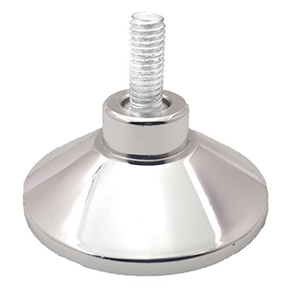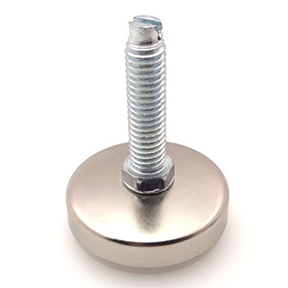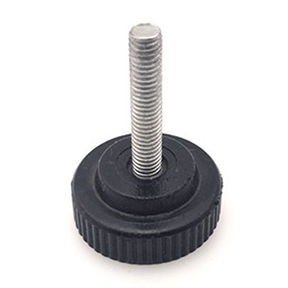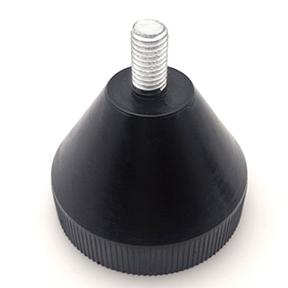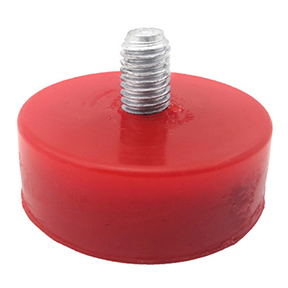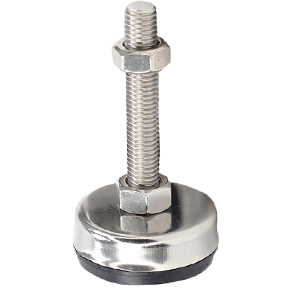No loose handles pressure cooker Research and Design
2013-07-05 13:24:25
The Su Qiang 1, Zhang Ping 1, Lan Hong Qiang 2
(1 College of Mechanical and Electrical Engineering, Southwest Petroleum University, Chengdu 610500; 2. Southwest Petroleum University, Ministry of Education Key Laboratory, Chengdu 610500)
Abstract: The pressure cooker handle with the connection between the blocks without guide positioning structure, relying on the force generated by tightening the screws to get fixed and tilt the pot when the friction torque transmission alone, this structure is prone to loosening. Hand in the traditional pressure cooker works and disadvantages of a large number of analysis and research, developed a new type of pressure cooker is not loose handle, replaced by engaging the friction force, in order to increase the torque, and its overall performance experimental results show that the novel is an easy to handle loose, long life, adaptable pressure cooker handle.
Keywords: hand; cooker; torque; friction
CLC: TH16 Document code: A Article ID: 1007 - 4414 (2012) 03 - 0115 - 03Research and development on a kind of no sliding pressure cooker hand shankSu Ben - qiang1, Zhang Ping1, Lan Hong - qiang2 (1 . Mechanical and electrical engineering institute, Southwest petroleum university, Chengdu Sichuan 610500, China; 2. Ministry of education key laboratory of oil and natural gas equipment, Southwest petroleumuniversity, Chengdu Sichuan 610500, China) Abstract: For the pressure cooker, there is no guidance and fixing structure between the handlebar and the interlink. And it isfixed only depend on the forces by tightening the screws. When the pot is tilted, the torque is transmited just by friction. It iseasy to get loosened. Therefore a new kind of handles of pressure cooker is designed after a large number of analysis and researchon handles of the traditional pressure cooker. It can augment torque by meshing force instead of friction. After the comprehensiveperformance test, the new pressure cooker handle is proved to be stable, applicable and longevous. Key words: hand shank; pressure cooker; torque; friction
1 Introduction
Pressure cooker cooking is one of the essential modern family. Because of the high temperature and pressure cooker has a unique function, thus greatly reducing the time, while saving energy [1]. Users in the use of a pressure cooker in the process, through to get started and start the implementation of the pot used in conjunction with the rotation of opening and closing. In most household pressure cooker, the pot body and have passed between the start of the connection shown in Figure 1 block.
① connecting block projection plane (Figure 1) and the inner concave handle friction produced; ② hand with the friction surface of the pot, the statically determinate principle known, there is a two forces only. After a period of a pressure cooker, loose handle, shown in Figure 2, the pot body and the gap between the handle, the friction between it decreases sharply, pouring pot object passing anti-torque capacity required also reduced [2 - 3].
2 Principle of traditional pressure cooker handle failure
In the process of using a pressure cooker, screws provided preload pressure cooker handles to prevent loosening plays a vital role, and therefore first analyze the screws at ambient and high temperatures difference. At room temperature, due to preload the screw connection is always close tight side thread outward side of the block, and the block loose side of the connecting thread to the inside edge of a gap; high, since the screw connection block, hand The different materials, the thermal expansion coefficient is not the same. If the screw is greater than the thermal expansion coefficient of the thermal expansion coefficient of connecting block, tighten the screw thread side the connecting blocks will be affixed to the outward side of the tighter, while the loose side of the screw thread to connect the block to the inside clearance between the edges more small, or even in contact, in this case, will tighten the screw at a high temperature even tighter; If the screw is smaller than the thermal expansion coefficient of the thermal expansion coefficient of connecting block, tighten the screw thread side the connecting block outward pressure between the edges smaller, but loose side of the connection block inside the internal thread of the contact pressure between the edges will increase, this will loosen the screws at high temperature. In the process of high temperature to a low temperature, both the screw connection block, or the handle can not return to the original state, therefore, the first case, the screws will be less than high preload force of the preload, the second case, the screws will be less than the original preload preload at room temperature. In either case, screw in the course will become loose.
During use, screw positive pressure directly affects the size and weight of its own pot pot body tilt (going to pour pot object) when the torque transmitted, and even cause the outer screw thread on the block with the connection between the internal thread loosening . If this time is greater than the frictional torque generated by the pressure pot object pour the required torque, the handle is not loose state; if positive pressure is less than the friction torque of the torque required to pour the pot body, the handle will loose. Hand loosened, if not timely tool tighten the screws, it will lead to long-term loose thread between leaving the thread failure. Even along the threads start to rotate around great inconvenience to the user. Pressure cooker handle structural defects caused by hand loose, so there is a pressure cooker in addition to the high pressure safety hazard, but also there from the start of the connection block, tipping the pot scald the user's security risks. In summary, the traditional pressure cooker handle structure has the following disadvantages.
(1) to start the connection between the blocks and the force generated only by tightening the screw to be fixed. Connect it with the screw on the block internal thread external thread due to temperature changes, different coefficients of thermal expansion and a gap, causing loose.
(2) to start the connection between the blocks of the positioning structure without guide.
(3) start the recess and projection connection block with a gap between the inclined object pouring pot, the pot body and the handle alone frictional force generated between the transmission torque is not enough, the handle Fast rotation also makes screw loose, this is the main reason for the handle loose.
3 Improved design of the handle structure
To overcome the above shortcomings of traditional autoclaves hand, meet different conditions (commercial, medical, military) using autoclave, are the principle by changing the force, pressure cooker in the conventional structure based on the handle to improve the design, to engage the force Alternative friction, so as to achieve the purpose of increasing the transmission torque. In this design, based on the real life in order to adapt to the presence of various sizes pressure cooker, make a small, medium and large models of the new pressure cooker connection block design.
3. A small pressure cooker handle structure
In order to adapt to the width of a small pressure cooker handle characteristics of small size in the smallest possible width as large as possible to pass anti-torque, made applicable to small as three new pressure cooker handle design [4]. In the original design based on the same to conventional connector block, based on the projections of its longitudinal extension to the side, so that the connecting piece presents itself as a "ten" shaped structure, the boss of the four sides of the protruding portion a symmetrically designed taper (15 ° ~ 20 °) slope. This connection block size is small, smaller size for general household pressure cooker. The structure shown in Figure 3 (a) shows the finished model shown in Figure 3 (b) in Fig. Figure 3 (a) can be seen, the boss portion projecting tapered ends, if the interior is also designed to handle the corresponding tapered recess, then it can be easily aligned with the connection block. Once it is automatically clamped to install, making it no longer a frictional force of nature, but the engaging force (like gears), thereby increasing torque to achieve the purpose of locking.
3. 2 medium-sized pressure cooker handle structure __
In the original design, based on the traditional connection block, based on the tapered (15 ° ~ 20 °) of the inclined block directly on the ends of conventional connector, both ends of the handle corresponds to a recess formed with the same taper slot. The structure shown in Figure 4 (a) shows the finished model shown in Figure 4 (b) in Fig. Figure 4 (a) shows that a new handle structure does not change the appearance of the traditional pressure cooker shape and size of the handle, simply connecting block design with the new internal structure adapted to handle, resulting in a pressure cooker without changing the original handlebar the appearance of the conditions, the use of the connection block and the handlebar can be achieved with the cooker body and the handle is not loose purposes. This structure is connected with the main force of the handle to its engaging force with the handle, but also a screw preload. The structure is simple, practical, easy processing, easy installation, suitable for ordinary families larger size pressure cooker.
3. 3 large pressure cooker handle structure
In the conventional connector block to add a pair of said projections on the groove, the groove taper to a certain extend to the upper surface of the connecting block. The structure shown in Figure 5 (a) shows the finished model shown in Figure 5 (b) in Fig. Figure 5 new handle large pressure cooker and refined model structure from Figure 5 (a) it can be seen the tapered recess, if the interior of the handle is also designed with a taper corresponding convex cross, then it can be easily aligned with the connection block, for mounting automatically after clamping, making its properties are not the friction force, but the engaging force, so that the torque increases, to the purpose of locking. This connector is slightly larger block sizes, suitable for medical sterilization units for cooking large pressure cooker.
4 mechanical analysis of two structures
Through the above structural design can be seen, these three structure using the same principle, both in the connection block on the basis of the original increase of slope, changing the nature of the torque delivered by hand, not the original friction torque, but the handle and connection block engaging force slant distance from the center of the screw to transfer the torque generated when pouring pot torque required. To facilitate the analysis, a second election now handle structure and the structure of traditional hand for comparison, is analyzed as follows.
4. Performance analysis of a conventional handle structure
Figure 1 and Figure 2, the situation in Figure 2 is greater than the friction torque of the friction torque generated in Figure 1, Figure 2 thus selected for further analysis can be. In the case of the object without dumping, the hand force in Figure 6 and Figure 7 (assuming the direction of the handle pointing to the axial center of the pot, in the direction perpendicular to the radial, the same below). The pouring object, the torque delivered by hand:
T = Σf · FN · ri
According to three o'clock stability principle, which provides maximum torque to take three points of reference, we have:
Tmax ≈ 3f · F0 Sang a2 + b2 (1)
Access to information to get the handle and the coefficient of friction between the pot f = 0. 03 ~ 0. 30. Known by experimental analysis, with the extension of the pressure cooker with the time t, between the handle and the pan to loosen, FN positive pressure gradually decreases, the transfer of the torque T is changed as shown in Figure 8.
4. 2 new handle structural performance analysis
The handle connecting structure by means of the engaging force transmission block the torque required to dump object. In the case of the object without dumping, the hand force shown in Figures 9 and 10. The pouring object, the torque delivered by hand:
T = 2Fy × r
Fy = F0 / (4 · tanα)
0. 68F0
By the formula (1), (2) the contrast can be seen in the initial stage, the new structure that can handle transmission of torque about the handlebar 1 conventional 1. 5 times. Since the new pressure cooker handle the torque T transmitted and friction coefficient regardless of the time t as a pressure cooker with the extension, even between the handle and the pan to loosen, preload force F0 decreases, the transfer is not affected by the torque T much impact, the change relationship shown in Figure 11.
5 Conclusions
From the above analysis and comparison Figure 12 can be seen, the traditional pressure cooker handle during use alone is not enough friction to transmit torque, with the use of time, which can drastically reduce the torque transmitted, even a time, can only rely on replacement handle, you can continue to use. New handle structure is completely changed cooker with friction torque transmission means, by engaging force transmission torque than the friction torque of the transmission has increased, especially in the use period of time, the new transmission torque capacity pressure cooker handle far more than the traditional handle. With the use of time, the ability to transfer torque handle modest decline, life is also greatly increased compared with the traditional handlebar. The new handle is easy to loose, large torque, long life, high-pressure applicability
Previous:Substation Control screen control handle loop problems and improvement of traffic lights Next:Workers and peasants, a 5-type tractor handlebar vibration analysis and evaluation of the test
Related News
- Fracture repair knowledge ruled handwheel handle
- Troubleshooting ruled bakelite hand wheel and troubleshooting
- Ruled handwheel is a natural bakelite handwheel
- Bakelite valve installation, operation and maintenance
- New pressure-filled rubber mold bakelite handle
- Large hydro elastic metal plastic Thrust Bearing Technology
- Our robot industry development trends
- CNC machine tools towline Forecast
- Rotating the handle needle valve
- Rotation of the handle shut-off valve


